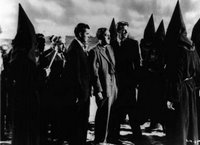
Adapted from a story by Cornell Woolrich (a suspense master whose work was also the source of Hitchcock's classic Rear Window), The Leopard Man (1943) was director Jacques Tourneur's last film for producer Val Lewton. Dennis O'Keefe stars as entertainment agent Jerry Manning on tour in New Mexico who hires a leopard to accompany dancer Clo-Clo (Margo) in a grand entrance to her act. Things backfire--the leopard is startled and escapes, and later appears to be responsible for a series of deaths. But while the first killing of a girl is undoubtedly the work of the leopard, Manning suspects that the subsequent murders may in fact be committed by a man, using the leopard as an alibi.
While the mystery plot is enjoyable but pretty thin, The Leopard Man holds three trademark Lewtonesque "dark fear" sequences, all involving the stalking and killing of a woman. Two of these stand out as landmarks in horror cinema.
The first is the much-discussed passage involving a girl entering the night, at her mother's insistence, to buy cornmeal. To do so, she has to pass under a bridge, which is thick with shadow and may harbour the black leopard. Masterfully shot and cut, this sequence invokes genuine dread of the dark, and includes what Tourneur describes as a "sharp edit". This sharp edit was known as "the bus" named after the sudden, startling cut to the hiss of a bus's brakes and door opening from Cat People. The bus in this sequence is a sound edit with the sudden shrieking of a vehicle passing over the bridge. This is more than a cheap shock--the slow, skilful build of fear in the sequence earns the effect. The sequence concludes with the film's most famous scene, involving terror behind a locked door and the seeping of blood.
The second landmark sequence is set at night (of course) in a walled graveyard, with a woman locked in, and convinced that something is lurking in the trees. The bending of a tree branch by the weight of something frightening is one of the most effective yet subtle payoffs to any suspense sequence.
The concept of inescapable fate, a key theme in many Lewton films, is also apparent here. There is a short passage of dialogue where one character points to a ball hovering in a fountain, and remarks that people are like that, being buffeted by forces beyond their understanding or ability to control. Inevitability also manifests itself in a scene with a fortune teller and a character who always turns up the death card, no matter how she cuts the cards.
Though the ending seems a bit rushed, The Leopard Man is required viewing for all horror/suspense film fans, especially for those interested in how editing, lighting, and sound can be used to economically build suspense. As Tourneur himself noted in an interview, Lewton's films were cheaply made, but never cheap.
The DVD pairs The Leopard Man with The Ghost Ship. The picture on The Leopard Man is not great. There are many speckles apparent throughout, but overall it is a notable improvement on the old VHS version. A restoration of the film would be nice.



No comments:
Post a Comment